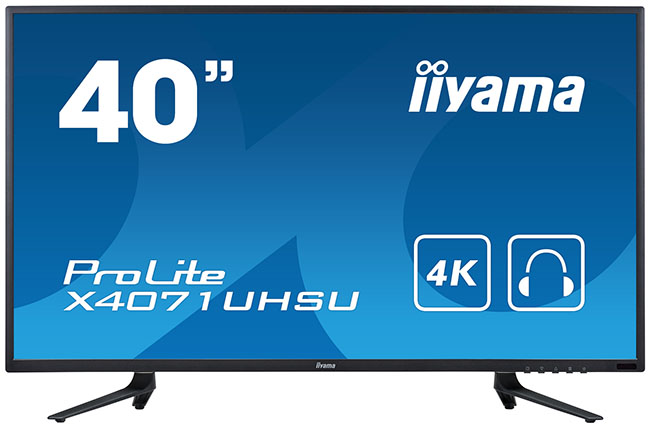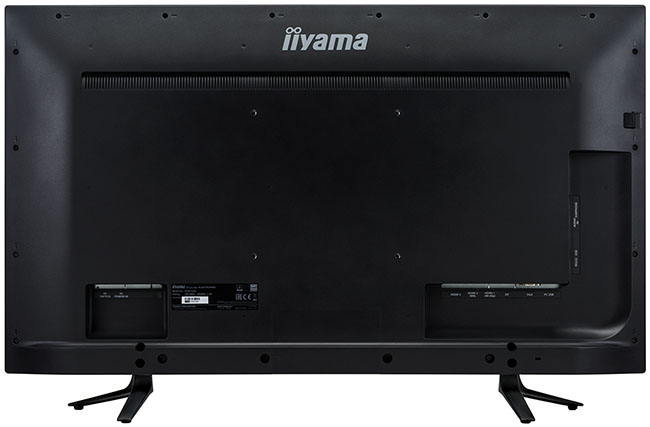Introduction
The 4K screen revolution is firmly upon us. Most premium TVs now boast the eye-popping pixel count while computer monitors are following suit. Want a 24in monitor with a 3,840x2,160 resolution? You needn't even spend £200.
A race to the financial bottom makes very poor sense for most manufacturers. Rather, we'd have them focus on creating screens that are a little different from the norm. One such PC monitor fitting that bill to a tee is the iiyama X4071UHSU - a 40in behemoth boasting a Multi-Domain Vertical Alignment (MVA) panel. Typically strong for deep-black reproduction and usually imbued with wide viewing angles, let's examine it in detail.
The huge screen, in terms of PC monitors, is disarmingly easy to setup: simply attach the two supplied feet, splayed outwards, and set on a desk. Worth knowing is that you need 75cm of real estate for it to sit comfortably. The chassis has a small bezel that's not the least bit distracting due to the massive panel size. The fixed nature of the feet means there's no adjustment available, but the screen feels as if it's tilting ever so slightly forwards. Perhaps it's just us.
X4071UHSU is made out of plastic but build quality is reasonable though not outstanding. It feels like an entry-level 4K television; there's no expensive metal or accents. And at 12.2kg it's a hefty beast. But let's talk about what's inside. The MVA panel has PWM control meaning that flicker can be noticed occasionally, and this is also true of the Philips BDM4065UC that it shares commonality with. Maximum refresh rate is 60Hz at 4K and, unfortunately but understandably at the £450 price point, it has no adaptive vertical sync technology such as G-Sync or FreeSync.
We noticed some vignetting when firing it up for the first time, with noticeable black splodges around the edge of the panel where it's in contact with the bezel. The culprit, in our sample's case, was overtightened screws on the back. Relieving some of the pressure cleared this problem.
Five buttons on the bottom right offer up control of a basic on-screen display. The control panel, as we have mentioned before, isn't as intuitive as on other displays, and there's no way to set the gamma curve. The monitor takes about 15 seconds to go from a power depress to showing an image which makes it feel sluggish. The huge size, though, makes it a perfect candidate for splitting the screen into various modes, and iiyama offers a wealth of multiview options within the control panel. Frustratingly, choosing the sRGB preset, which has superb colour accuracy, locks out the brightness control; the monitor is set to 100 per cent and is way too bright in our opinion.
The monitor's inputs are set to auto by default. Note that connecting a graphics card by either HDMI or DisplayPort forces the screen to display its native 4K resolution at 30Hz instead of 60Hz, even though the monitor supports it. The culprit is the auto-input selection that chooses DisplayPort 1.1 and HDMI 1.4. One needs to go into the setup section and adjust both inputs to v1.2 and v2.0, respectively, curing the problem. Do be aware that getting AMD cards to 4K will require the use of a DisplayPort cable alone.
On a more positive note, iiyama bundles all the necessary cables and a small remote that replicates the functions of the five buttons. It makes it far easier to change the options this way. We found there little need to ever touch the OSD or power buttons again, so perhaps iiyama could consider getting rid of them in a future model.
The rear houses two 6W speakers that provide a much better audio experience than on other monitors, clearly helped by the larger chassis and flared section near the bottom. This also houses an integrated power supply so you only need a standard 3-prong power cable going into the left-hand side. There's a central 200mm x 400mm VESA mount for placing the screen on the wall, and it's important in this case as we imagine a number of prospective buyers will go for this option rather than have it sitting at close quarters, in a fixed position, on the desk.
You can see the the right-hand HDMI port is the only one with the necessary bandwidth to drive the screen at 4K60. You don't need any special HDMI cables for it, mind, as the higher-refresh processing is done on the monitor and graphics card sides.
Two side-mounted USB 3.0 ports are always nice. On the other side, catering for the gamer, iiyama adds an extendable arm which serves as a headphone holder when you're between sessions.
A truly massive amount of screen real estate is the real draw at a sub-£500 price point. Let's now see how it performs.














